Hula Hoop Games and the Complete Guide to Hula Hooping
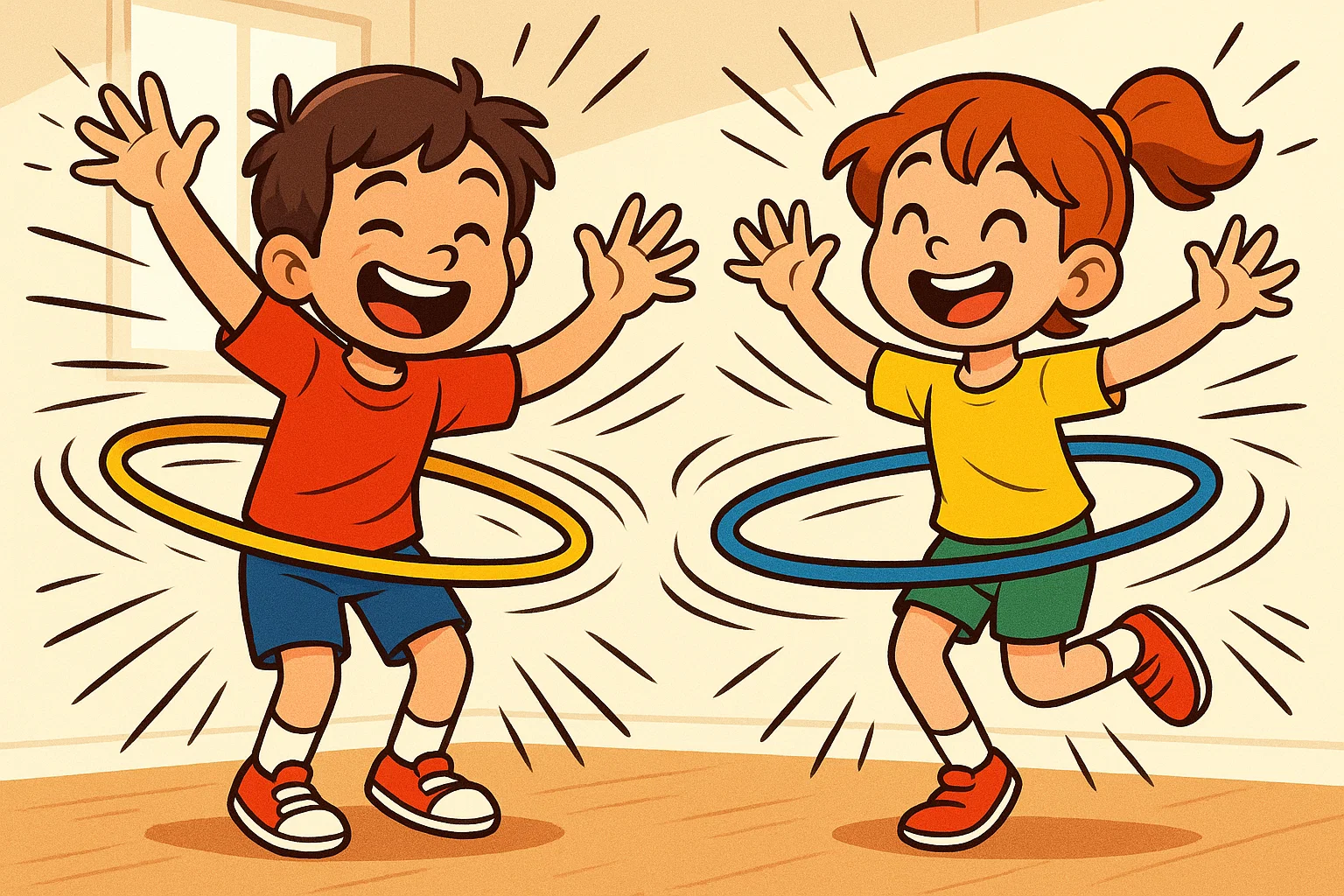
Hula hoops have captivated children for generations, offering far more than simple circular play. These versatile tools transform ordinary afternoons into opportunities for physical development, social interaction, and creative movement. Whether you’re planning activities for birthday parties or seeking ways to get kids outside and active, these games provide endless possibilities that engage children’s bodies and minds simultaneously.
Hula Hoop Games for Coordination and Strength
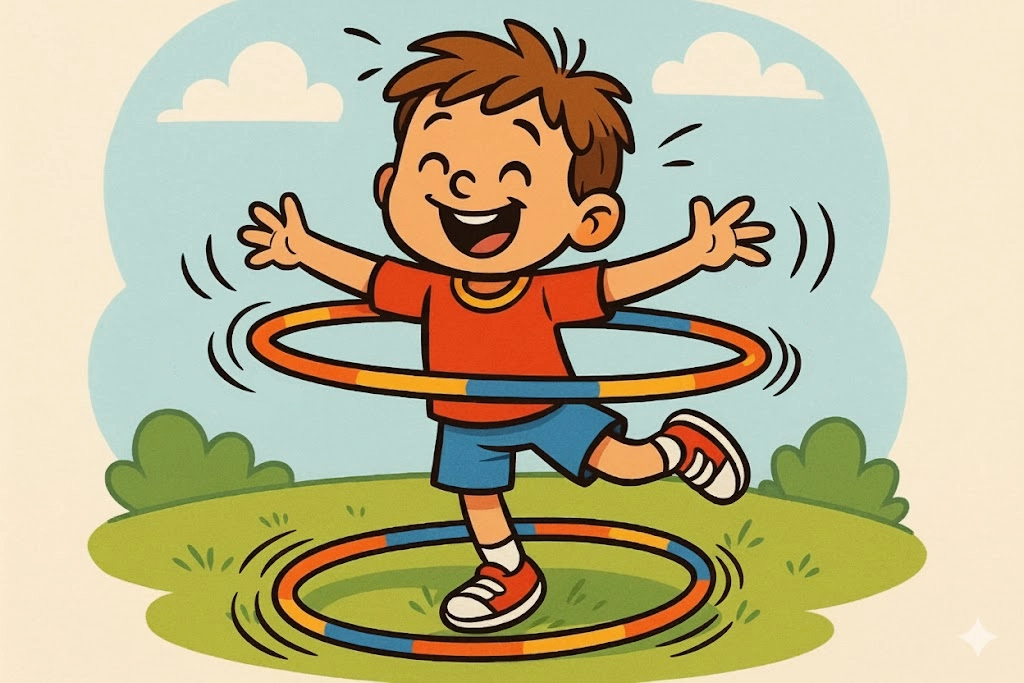
Individual activities form the foundation for developing essential physical skills. These games allow children to progress at their own pace while building confidence in their abilities.
Classic Hula Hooping and Body Spinning
The traditional hoop around the waist remains a cornerstone activity. To start the game, give each child one hoop and demonstrate the basic motion: place it against your lower back, give it a strong spin to one side, and rock your hips forward and backward to keep momentum. Children typically need multiple attempts before finding their rhythm, which builds perseverance.
Beyond waist spinning, encourage children to move the hoop around different body parts. Advanced players can loop it around arms, legs, or even their neck. According to pediatric physical therapist Dr. Sarah Mitchell, “Multi-plane movements help children develop proprioception—their sense of body position in space—which is fundamental for all physical activities.”
| Skill Level | Body Position | Average Success Time |
| Beginner | Waist | 2-3 weeks of practice |
| Intermediate | Arms/Legs | 1-2 months |
| Advanced | Neck/Multiple hoops | 3+ months |
Strength and Endurance Challenges
Challenges that focus on duration and repetition build muscular endurance. Set up two stations where children can practice different techniques:
Station One: Endurance Spinning – Children attempt to keep the circle spinning for progressively longer periods. Start with 10-second goals and gradually increase. This activity engages core muscles continuously and improves cardiovascular fitness.
Station Two: Rotation Counting – Challenge children to complete a specific number of rotations without dropping. Count aloud together, which adds a rhythmic element that helps maintain momentum.
These activities naturally incorporate interval training principles, allowing children to rest between attempts.
Jumping and Hopscotch Patterns
Combining hoops with jumping creates dynamic movement patterns. Place two hoops on the ground about two feet apart. Children can:
- Jump from one to the other with both feet together
- Hop on one foot between circles
- Even frog jump from the center of one to the next
- Create hopscotch-style patterns with multiple rings in various configurations
For added complexity, arrange five or six in a winding path. Children navigate through by jumping, hopping, or using designated foot placements. This modification turns simple jumping into a coordination puzzle that requires planning and body control.
Team Hula Hooping Activities and Relays
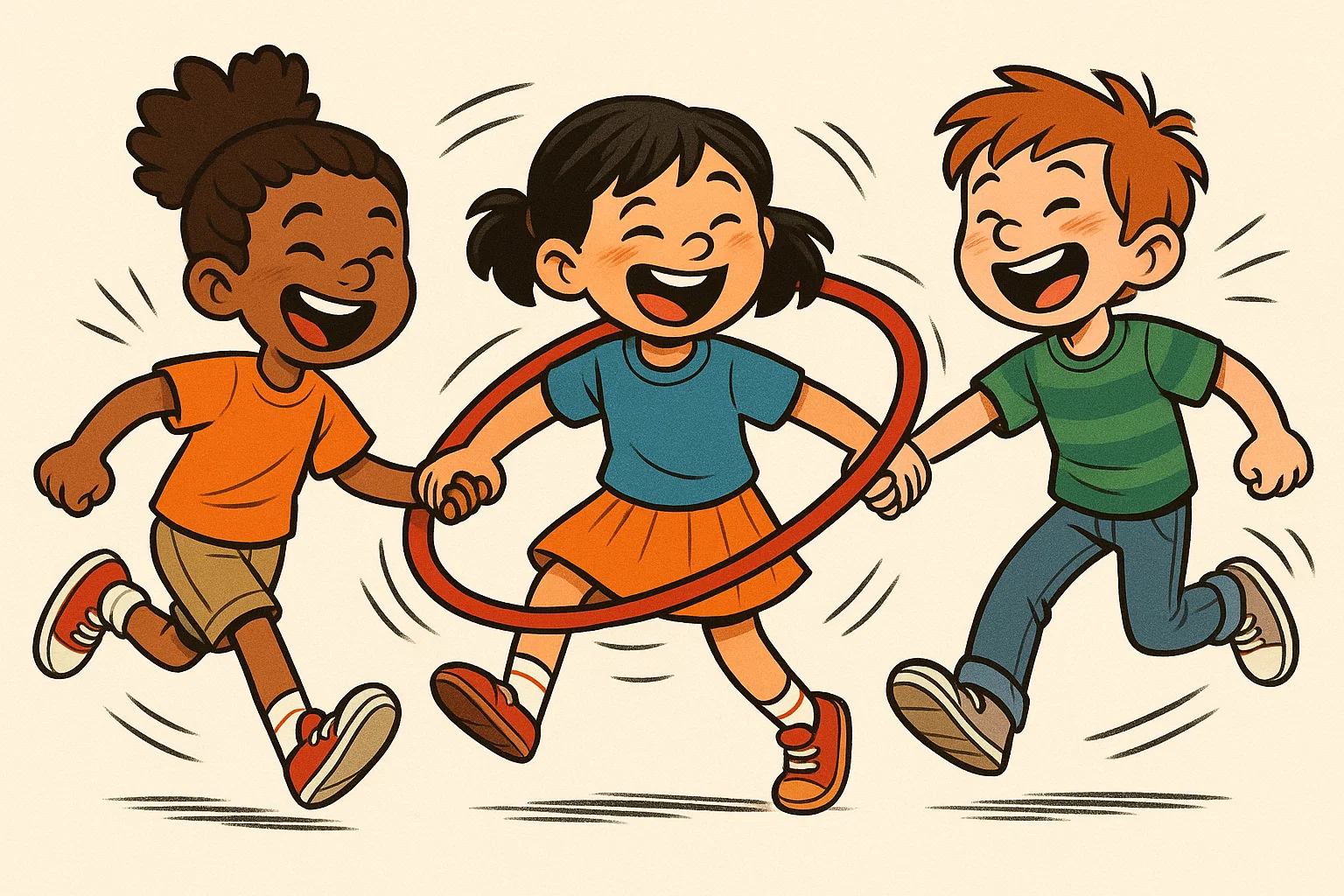
Group activities foster cooperation and social skills while maintaining high energy levels. These games work particularly well for birthday parties or classroom settings where you need to engage multiple children simultaneously.
Hula Hoop Team Relay Pass
A relay race adds a unique twist to traditional running games. Divide children into teams of four to six. Set up two cones approximately 30 feet apart for each team.
How to Play:
- The first player holds a hoop and runs to the far cone
- They circle the cone while spinning it around their waist
- They run back and pass to the next teammate
- The relay continues until all team members complete the course
This game requires enough hula hoops for each team—typically one per team is sufficient. The challenge of maintaining momentum while running creates genuine difficulty that equalizes competition between different skill levels.
The Musical Hoops Game
Similar to musical chairs, this activity combines listening skills with quick decision-making. Scatter circles around your play area—use one fewer than the total number of children. When music plays, children move around freely. When it stops, each child must quickly find a hoop and stand inside.
Unlike competitive elimination games, consider using a cooperative variation: children who don’t secure a spot must perform a fun movement (five jumping jacks or a silly dance) before rejoining. This approach maintains engagement without creating disappointment.
Snatch the Hoop: An Energetic Group Game
This high-energy game works best with groups of eight or more children. Place one hoop in the center of your play area, creating a base. Form two teams on opposite sides, numbering each player (both teams have a player one, player two, etc.).
When you call a number, those two players race to grab the circle and return it to their team’s side. The twist: if a player touches first, they can pick it up and run. If both touch simultaneously, they must hoop along—both holding while trying to pull toward their side. First player to cross their team’s line earns a point.
Accuracy Games: Ring Toss and Targets
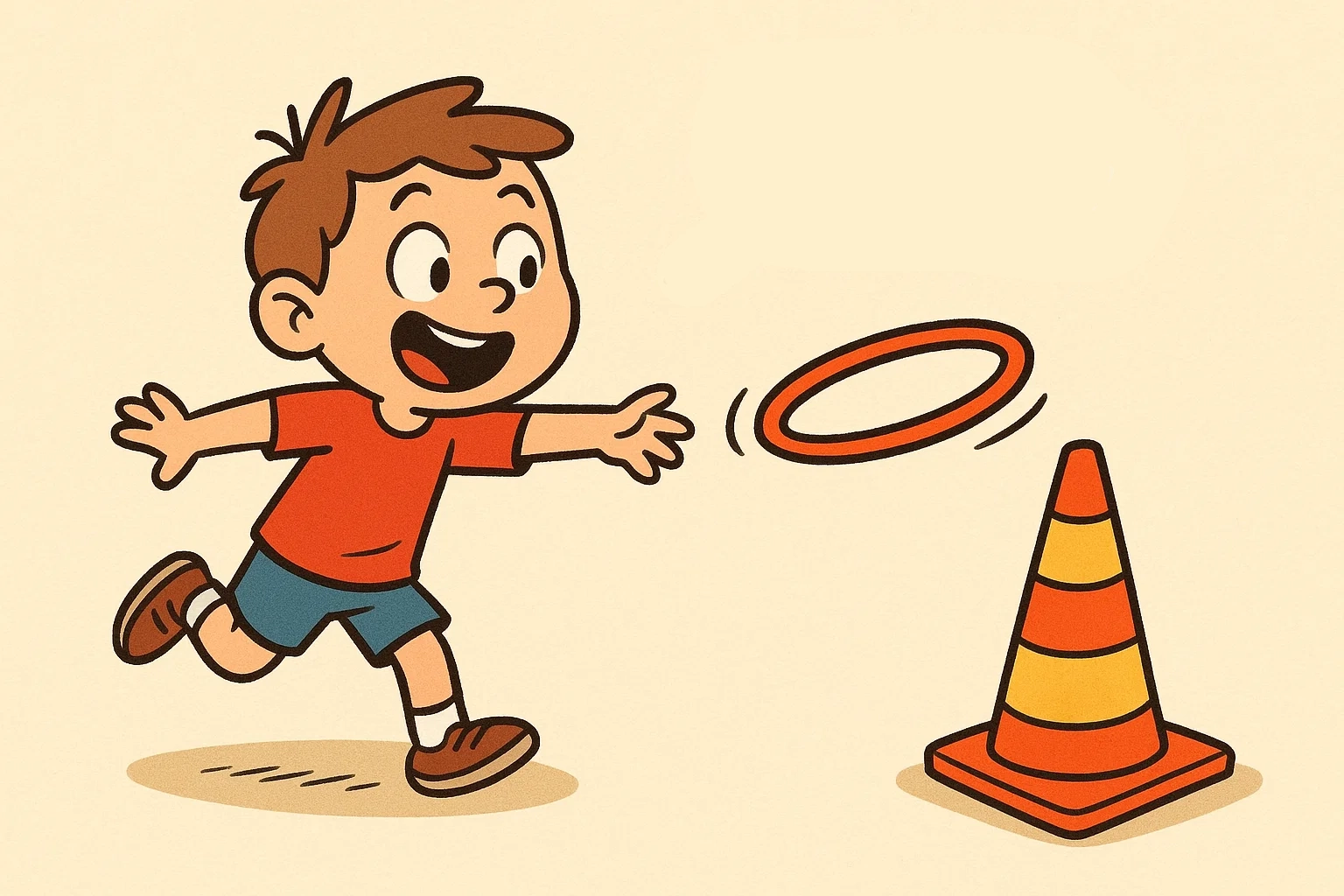
Precision-based activities develop hand-eye coordination and spatial judgment. These quieter games provide excellent contrast to high-energy running activities.
Classic Ring Toss Over Cones
Ring toss remains one of the most adaptable games. Set up two or more plastic bowling pins or traffic cones at varying distances—start at three feet for younger children, extending to ten feet for older kids.
Each player receives three to five hoops and attempts to toss them over the cone. Unlike traditional ring toss with small rings, the larger size actually increases difficulty because children must account for diameter in their throw trajectory.
Scoring Variations:
- Simple: One point per successful toss
- Distance-based: Closer cones worth 1 point, farther cones worth 3 or 5 points
- Color-coded: Assign point values to different colored cones
Dr. James Chen, a developmental pediatrician, notes that “accuracy games provide immediate visual feedback that helps children adjust their motor planning. They can see exactly where their throw landed and modify their next attempt accordingly.”
Hoop Targets for Beanbags and Balls
Transform circles into ground targets for throwing practice. Lay several flat on the ground at different distances. Children toss beanbags or soft balls, aiming to land them inside. This modification works particularly well indoors where vertical tosses might damage fixtures.
Create targets for beanbags by placing in patterns—arrange them in a triangle formation or create a target-style layout with a center circle surrounded by others. Assign point values to different positions, encouraging strategic decision-making about risk versus reward.
Throw the Hoop High: A Catching Challenge
This partner activity builds both throwing and catching skills. One child holds the circle vertically and tosses it upward with backspin, causing it to return. Their partner attempts to catch the descending ring. Start with short tosses and gradually increase height as children’s confidence grows.
For solo practice, children can throw upward and catch themselves, which requires spatial prediction skills. Some children discover that adding slight rotation helps stabilize the flight path.
Movement Games Featuring the Jump Rope
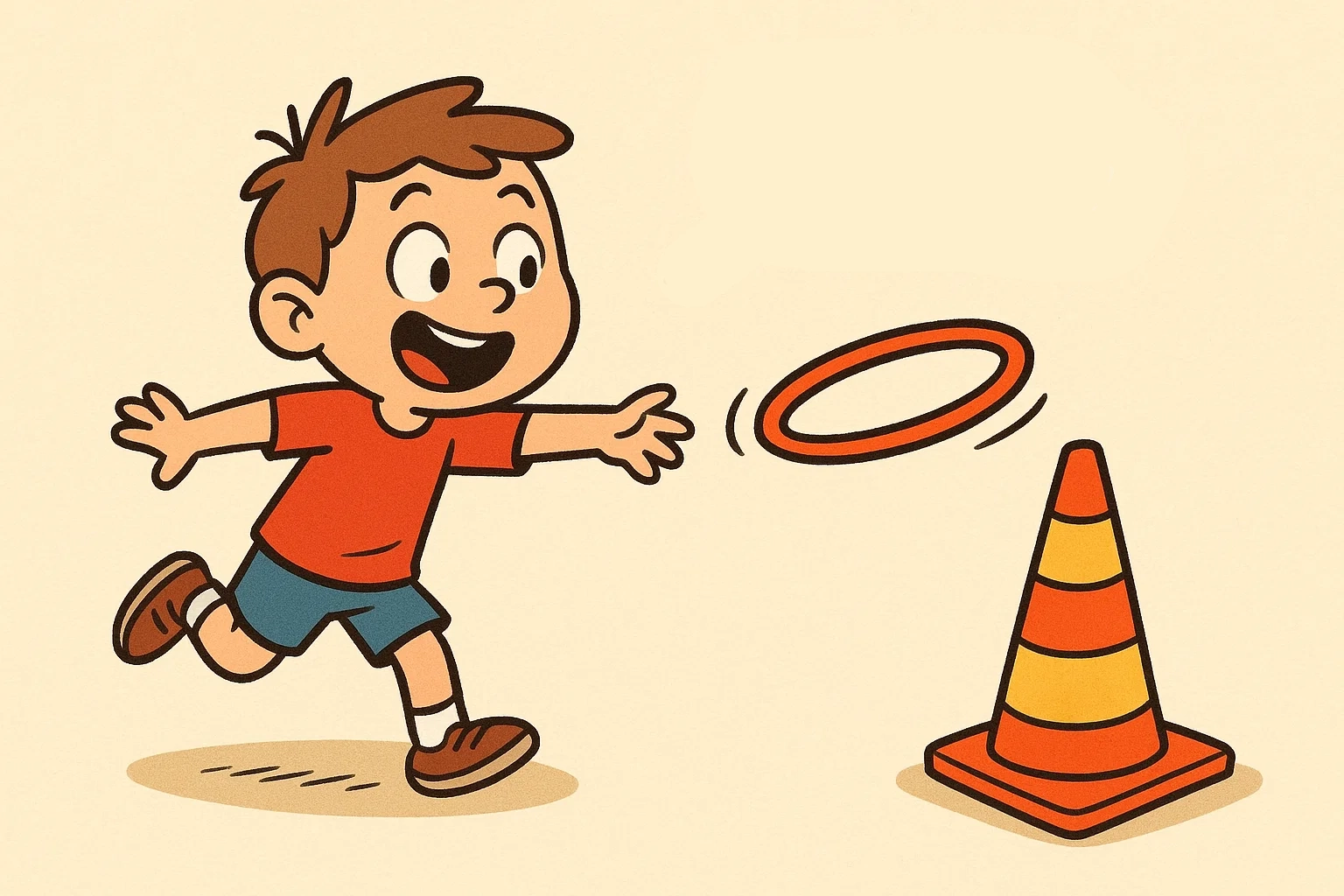
While jump rope typically refers to traditional rope activities, hoops can supplement or replace ropes in several creative ways.
Hula Hoop Jump Rope Skipping Motion
Two children hold opposite sides of a hoop and create a swinging motion similar to jump rope. A third child jumps over as it swings back and forth at ground level. This adaptation works well for children still developing the timing required for traditional rope jumping, as the slower, more visible movement provides clearer visual cues.
Progress from simple back-and-forth swings to circular rotations, where children must jump as it passes beneath their feet in a continuous motion. This skill bridges the gap between static jumping activities and full rope mastery.
Roll the Hoop: Chase and Catch
Rolling challenges children’s coordination and prediction abilities. One player stands the circle vertically and pushes it forward, causing it to roll. They then chase and catch before it falls. Successful players can roll a hoop remarkable distances—outdoor spaces with gentle slopes work particularly well.
Create a competitive element by marking distance milestones with cones. Children attempt to roll past each marker before catching, progressively extending their control distance. A 2021 study from the Committee on Physical Activity and Physical Education in the School Environment found that rolling activities help develop visual tracking skills that support reading development.
Obstacle Navigation: Up, Down, and Over
Design an obstacle course incorporating circles at various heights and positions. Children might:
- Crawl through hoops held vertically by partners or positioned in stands
- Step carefully through laid in overlapping patterns on the ground
- Duck under suspended at shoulder height
- Jump over positioned as hurdles
This type of physical activity engages children’s executive function as they plan their movement sequence through the course. Change the configuration regularly to maintain interest and prevent memorization of patterns.
Creative Hula Hoop Games for Fun
Imaginative approaches expand possibilities beyond traditional activities, particularly appealing to children who prefer creative movement over competitive games.
Animal Walks Through Hoops
Combine pretend play with physical challenge by assigning animal movements. Lay circles in a path and announce different animals at each station:
- Bear walk: Hands and feet on ground, bottom in the air, walking through
- Crab walk: Sitting position, hands behind, feet forward, moving sideways or backward
- Frog jump: Deep squat position, jumping forward into each circle
- Snake slither: Lying prone, using arms to pull body through without touching the ring
- Bunny hop: Crouching with hands forward, bringing feet up to hands in hopping motion
This activity works exceptionally well with younger children (ages 3-6) who enjoy imitation and storytelling elements. Parents report that adding simple narratives—”We’re traveling through the jungle to find treasure!”—significantly extends engagement time.
Hula Hoop Limbo for Fun and Flexibility
Traditional limbo uses a horizontal bar, but the hoop might serve as a more forgiving alternative. Two children hold horizontally at chest height. Other children pass underneath without touching, leaning backward to fit through. After each round, lower slightly.
The circular shape provides interesting challenges that differ from straight bars—children must navigate not just height but also the enclosed space. Some creative children discover that turning sideways or using different body angles helps them succeed at lower heights.
Hula Hoop Basketball
Suspend from a tree branch, playground equipment, or basketball rim to create an alternative basketball goal. Children toss soft balls through the elevated target. The unique challenge lies in flexibility—it moves when hit, requiring players to time their shots when the target steadies.
For indoor play, have one child hold at various heights and positions while others attempt shots. Rotate the holder regularly so everyone experiences both roles. This cooperative approach removes the pressure of competition while maintaining the skill-building challenge.
Benefits of Hula Hooping for Child Development
Understanding the developmental advantages helps parents and educators recognize their value beyond simple entertainment.
Improving Motor Skills and Spatial Awareness
These activities engage multiple motor skill categories simultaneously. Gross motor skills develop through large movements like jumping and running, while fine motor adjustments help children maintain rhythm and balance. The American Physical Therapy Association notes that rotational activities specifically support the development of bilateral coordination—the ability to use both sides of the body in harmony.
Spatial awareness improves as children learn to judge distances, angles, and trajectories. When attempting to toss a ring onto a cone, children unconsciously calculate arc, force, and direction. These spatial reasoning skills correlate with mathematical aptitude in later academic years, according to research published in The British Psychological Society.
Physical Fitness and Health
Regular activities provide significant cardiovascular benefits. For children, ten to fifteen minutes of active play contributes meaningfully toward the CDC’s recommendation of 60 minutes of daily physical activity.
Core strength develops naturally through the stabilization required to keep circles spinning. Children engage abdominal and lower back muscles without the tedium of structured exercises. Physical education instructor Marcus Thompson observes, “Children building core strength through play are far more likely to maintain regular physical activity than those introduced to fitness through conventional calisthenics.”
| Physical Benefit | Activity Type | Estimated Improvement Period |
| Cardiovascular endurance | Continuous spinning, relay races | 4-6 weeks |
| Core strength | Waist spinning, balancing games | 6-8 weeks |
| Coordination | Ring toss, target games | 8-12 weeks |
| Balance | One-foot activities, limbo | 6-10 weeks |
Boosting Confidence and Mood
Mastering tricks provides tangible achievement markers. Unlike many childhood activities where progress occurs gradually, children can often pinpoint the exact moment they successfully maintained a spin for ten rotations or landed three consecutive ring tosses. These clear victories build self-efficacy—children’s belief in their ability to accomplish goals.
The repetitive, rhythmic nature may also produce mild mood-enhancing effects. Pediatric psychologist Dr. Amanda Richards explains, “Rhythmic physical activities can promote the release of endorphins and create a meditative quality that helps children regulate their emotional states. Parents often report that active play sessions precede calmer, more focused periods.”
Social benefits emerge naturally from group activities. Children learn to take turns, encourage peers, celebrate others’ successes, and handle their own setbacks in supportive environments. These social-emotional skills transfer to classroom and family settings.
Organizing Hula Hoop Games and Safety
Thoughtful preparation ensures that activities remain safe, inclusive, and enjoyable for all participants.
Choosing the Proper Hoop Size
Diameter significantly affects success rates. When standing a circle vertically next to a child, the top should reach somewhere between their waist and chest. Smaller ones spin faster but require quicker hip movements, while larger ones rotate more slowly, giving children more time to adjust their rhythm.
Size Guidelines:
- Ages 3-5: 28-30 inch diameter
- Ages 6-8: 32-34 inch diameter
- Ages 9-12: 36-38 inch diameter
- Teens and adults: 38-42 inch diameter
Weight also matters. Lightweight versions work well for arm tricks and tossing games, while slightly weighted ones (around 1-2 pounds) maintain momentum more easily for waist spinning. Ensure you have enough hula hoops for your planned activities—group games typically require one per participant, plus a few extras for breakage.
Safety Guidelines for Outdoor and Indoor Play
Outdoor activities require adequate space free from obstacles. Survey your area for rocks, exposed roots, or uneven terrain that might cause trips or falls. When kids outside play, establish clear boundaries so running games don’t lead children into hazardous areas like streets or water features.
Indoor play demands different considerations. Low-hanging lights, ceiling fans, and fragile decorations should be protected or turned off during active games. Hard floors can cause circles to bounce unpredictably and may injure children who fall, so consider using gymnasium flooring or carpeted areas when possible.
Safety Checklist:
- Inspect equipment before use for cracks or sharp edges
- Establish rules about swinging near others’ faces
- Ensure adequate spacing between children during individual activities
- Keep water available for hydration during extended play sessions
- Monitor for signs of overexertion, especially in warm weather
Encouraging Non-Competitive Fun
While some children thrive on competition, others withdraw when games emphasize winning and losing. Structure activities to celebrate personal improvement and effort alongside achievement. When you start the game, frame it around exploration: “Let’s see how many different ways we can move through these hoops” rather than “Who can jump through the fastest?”
For birthday parties or large groups, consider cooperative goal-setting. Challenge the entire group to collectively achieve 100 successful ring tosses rather than determining individual winners. This approach maintains engagement while reducing the social stress that can discourage less-athletic children.
Rotate roles regularly in activities requiring different positions. In games where some children hold while others jump or toss, switch positions every few minutes. This ensures everyone experiences various skill challenges and prevents any child from feeling relegated to a “lesser” role.
Frequently Asked Questions (FAQ)
How do you make hula hooping a fun for kids activity?
Making hula hooping fun often involves turning it into a game! Try setting up different hula hoop challenges, like seeing who can spin it the longest or trying to pass the hoop over their body without using their hands. You can also incorporate other activities, such as asking them to move inside the hoop for a safe zone in a game of tag, or having them try to loop the hoop over a target for a simple form of ring toss.
What are some creative ways to move the hula hoop without spinning it on your body?
One excellent activity is hoop rolling. Teach children how to roll the hoop along the ground and chase it. For a cooperative challenge, two players can try to keep the hoop rolling back and forth to each other—you can even make it a team event where they have to hoop along a specific path without letting it fall. The phrase “hula hoop might” is a fun way to introduce new possibilities, asking, “How many ways do you think a hula hoop might move?”
How can I use a hula hoop to mark a safe zone or boundary?
The hula hoop makes a perfect hoop base or “home” in games. Place several hoops on the ground and designate them as safe spots. For example, in a game of “Shark and Minnows,” the hoops are islands, and players are safe as long as they are standing inside the hoop. This transforms the simple ring into a strategic element of the game.
